Why is it so critical to read food labels post Covid-19?

Health & Lifestyle
272 week ago — 15 min read
While Covid-19 has become a global pandemic, consumer buying behaviours have changed tremendously. Shutdowns are continuing, families are at homes, consumers are trying to cut expenses to tackle the reduced income. However, there have been reports that consumers are adopting new brands, new channels and behaviours. The Covid-19 pandemic has changed the way we choose, we shop, and we eat.
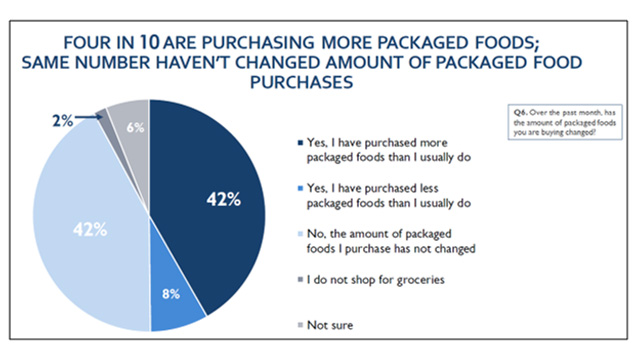
Source : Covid-19 | IFIC 2020 | FoodInsight.org
People are choosing to eat healthy, fresh meals at home but it is observed that they are buying packaged foods and stocking their kitchens. The focus on immunity and good health, specially coming from food and good nutrition is a priority for consumer. This makes it imperative for consumers to read labels, compare similar products and choose the ones that are best suited for our health.
The Covid-19 pandemic has changed the way we choose, we shop, and we eat. Consumers are adopting new brands, new channels and behaviours.
Food labels provide a lot of helpful information if one take the time to read it. While a small part of the food label is fairly simple and straightforward, certain parts require a contextual understanding of all the numbers and their actual meaning.
The information on each food label is crisp, concise and condensed to fit in to the small pack size of the product. Not all the information applies to consumers, but it is important from consumers to know what the information means and pick up the data points that are applicable to him/her.
Also read: How to read nutritional labels to make smarter food choices
3 reasons why you must read food labels today
1. Know what you are eating
A food label reflects the true nature of the food products. The list of ingredients, the nutrition information panel, list of additives, allergens and more – define the true nature of the products and enable consumers to understand the impact of the food product on their bodies.
2. Make healthier food choices
Understanding what's in the food you eat helps you make healthier choices. Checking food labels helps us compare similar products and select the one with a better nutrition profile than can impact our health positively.
3. Improve the quality of your food intake
Reading food labels evokes consciousness towards the intake of excess calories, fat, sugar and salt – three nutrients responsible for the increasing incidence of non-communicable diseases. Checking food labels for positive nutrients like protein, fibre, calcium, iron, etc can improve the intake of these nutrients in our diet.
Reading labels is complex, and it is hard for consumers to understand the label.
Here is a step-by-step guide on how to read and comprehend a food label
1. Turn the pack – the most vital information is at the back!
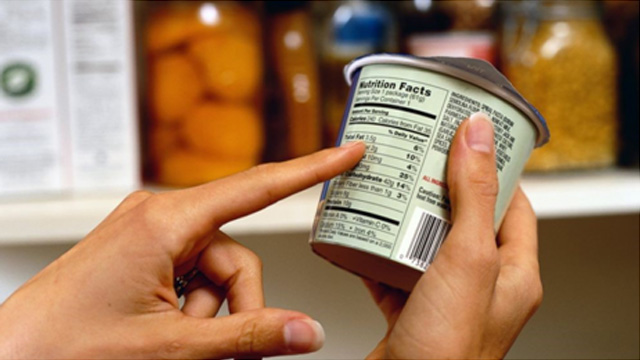
The front of the pack health claims are often just the half truth about any product. They are often written in an attractive manner, to influence consumer purchase. Often products mention claims like low fat, high fibre in the front – only for us to realise that the product is high on sugar and sodium.
The nutritional information table at the back, is where the story lies. Unfortunately, that the section which is completely ignored and misunderstood. A detailed nutrient-wise information panel dissects the products and tells you exactly what you are eating.
2. Read the ingredient list
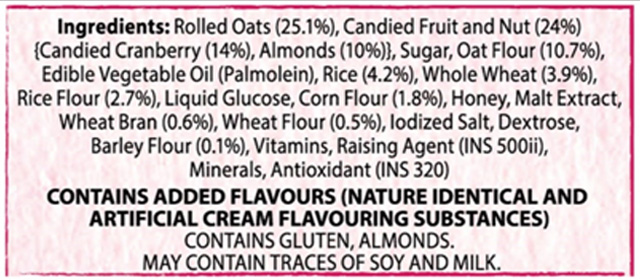
The ingredient list is one of the most critical parts of a food label. It gives you a list of items that constitute the product. Whilst reading the ingredient list , take care of the following points:
a. The ingredient list is written in descending order of quantities. The first 3-4 ingredients on the list pretty much sums up what the product is made up of. Make note of the first 3 ingredients on the list – if the names include refined grains/flour, hydrogenated fat, or a type of sugar, then the product must be skipped. Select products that are made up of whole grains, pulses, nuts & seeds or fruit and vegetables largely.
b. Shorter the ingredient list, healthier the product. Go for products that are made in less than 10 ingredients. Longer ingredient lists indicate highly processed foods, with a number of food additives.
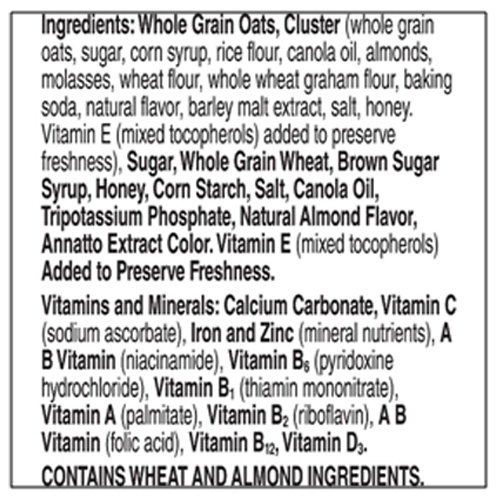
c. Look for ingredients on the label that you recognise and are familiar with. Products made with ingredients found in your kitchen are far more healthier than the ones created in labs.
d. Look out for masquerading ingredients – especially sugar and salt. Sugar is present in 70 different forms in packaged food products and one must be wary before you select any product blindly. Sodium is not only present in salt, but also in food additives like baking powder, baking soda, preservatives, flavour enhancers, sequestrants and more.

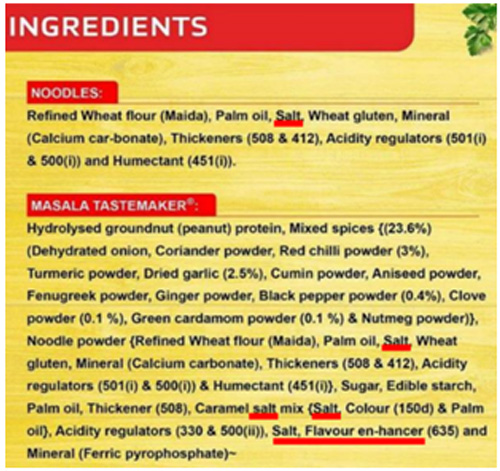
3. Check the food additives below the ingredient list
Food additive classes are often declared together with their specific names or the INS (International Numbering System) codes. While most food additives are listed under the ingredient list, special rules apply to flavourings, colourings and preservatives.
Most flavourings need to be listed individually – mentioning ‘natural flavouring substances’, ‘nature-identical flavouring substances’ or ‘artificial flavouring substances’ as applicable.
a. Natural flavouring substances are extracted from plants, herbs and spices, animals, or microbial fermentations.
b. Nature-identical flavouring agents are the flavouring substances that are obtained by synthesis or are isolated through chemical processes.
c. Artificial flavouring agents are chemically similar to natural flavourings, but synthesised artificially and contain no natural or nature identical substances.

Please note, FSSAI mandates the use of approved flavouring agents (and other additives) only. So even if the label mentions ‘artificial flavouring substances’, they are safe to consume and possess no toxicity threat.
Consumer choice is now beginning to tip in the favour of natural substances – be it flavour, colour, or any other additive. Clean label products , created without the use of artificial substances are manifesting an increase in consumer adoption. We are seeing increasing number of consumers consciously choose products that are natural and sans any artificial additives.
4. Nutrition information panel / Nutrition label
The nutrition information on the food label is a mandatory description intended to inform the consumer of the nutritional properties of the food product. Nutrition Information is often written per 100gm/100ml or per serve on the label.
The nutrition information on the food label holds the most critical information about the product and can help you make healthier choices. 5 things that you MUST check on the nutrition information panel before you pick any product –
a. Serving size
One serve is the amount of food customarily consumed per eating occasion, which is expressed in metric unit or given in common household measures like tea spoon, table spoon, cup that is appropriate to the food. This will tell you how many servings are there in the pack. Serving sizes are standardised to enable us to compare similar food products.
We often confuse serving size with the pack size, which could prove to be harmful, as it increases the risk of overeating without you realising it. This is largely observed in the case of chips, biscuits, juices and soft-drinks. We could end up consuming twice the recommended calories, fat, sugar or sodium if we do not pay attention to serving sizes.
Many people are unaware of this serving size format, and assume that the entire container is a single serving, when in reality, it may consist of two, three, or more servings. Do remember, serving sizes are only an indication of how much people consume in one sitting. It is not a recommendation of how much should be consumed.
b. Beneficial vs Harmful nutrients
All nutrients declared on the nutrition label can be divides into 2 sections – beneficial nutrients and harmful nutrients.
Beneficial nutrients are the nutrients that you must get more of – protein, dietary fiber, calcium, iron, vitamin D, vitamin A, vitamin A, potassium. These nutrients are beneficial to the body and our health. We often don’t get enough of these nutrients and it is imperative to consume them in adequate amounts. Whilst comparing products, choose the foods that are high in these nutrients.
On the other hand, harmful nutrients are the nutrients that you must limit or get less of – saturated fat, trans fat, total sugar, added sugar, sodium. Saturated fat, sodium, and added sugars are nutrients listed on the label that are directly associated with adverse health effects and non-communicable diseases. Follow one rule for these nutrients – lower the better!
c. % Daily Value - Per serve percentage (%) contribution to RDA
While the nutrition information panel on Indian food labels are mostly written per 100gm/ml, FSSAI does suggest that brands must mention the nutrition information per serve and the per serve percentage (%) contribution of nutrients to their respective RDAs. Per serve percentage (%) is also know as Daily Value (%) and is calculated for a standard 2000-kcal diet.
The % Daily Value (%DV) is the percentage of the Daily Value for each nutrient in one serving of the food product. The Daily Values are reference amounts (expressed in grams, milligrams, or micrograms) of nutrients to consume or not to exceed each day.
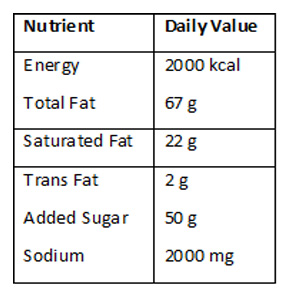
Source : FSSAI Draft Regulations (Labelling & Display), 2019
The %DV shows the quantity of a nutrient in one serving of a food against your daily requirement, and helps you determine if a serving of food is high or low in that nutrient.
Follow the 5-20 rule each time you read the %DV on the Nutrition Information panel.
- 5% DV or less of a nutrient per serving is considered low
- 20% DV or more of a nutrient per serving is considered high
Choose foods that have a high %DV for beneficial nutrients - protein, dietary fiber, calcium, iron, vitamin D, vitamin A, vitamin A, potassium. Choose foods that have a low %DV for harmful nutrients - saturated fat, trans fat, total sugar, added sugar, sodium.
The upside to % Daily Value is that it is a great tool for comparing similar products per serve. It also helps trade-off products and bring in our favourite foods into our diet, once a while. However, the downside to the % Daily Value is that it is calculated for a standard 2000-kcal diet for all adults and children above 4 year age. However, calorie and nutrient recommendations change with age, gender, physical activity and nutrient intakes must be monitored differently for individuals.
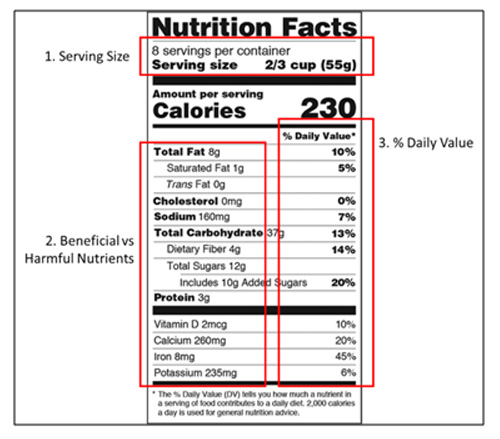
5. Allergens
Allergens are substances that cause an immune response (allergic response) in certain people, which could even be life-threatening in extreme cases. Foods containing one or more of the eight common allergens must be listed prominently on the label.
Allergens are usually found below the list of ingredients. The common 8 allergens mandated for declaration by FSSAI are –
- Cereals containing gluten; i.e., wheat, rye, barley, oats, spelt or their hybridized strains and their products
- Crustaceans
- Milk & Milk products;
- Eggs and egg products;
- Fish and fish products;
- Peanuts, Tree nuts and their products;
- Soybeans and their products;
- Sulphite in concentrations of 10mg/kg or more.

6. Date marking
You may see 3 types of date marking on your food product – ‘date of manufacture or packaging’, ‘Expiry/Use by’ or ‘Best before’.
- Date of manufacture is the date on which the food product was manufactured and packaged.
- Expiry/Use by date tell you how long with the food remain at its best quality and will not be fit for consumption post the date. This is often used in perishable products like milk, bread, etc.
- Best Before date guarantees the quality of certain properties of the product to be effective up to this date. Once the date has passed, it may just lose its freshness, taste, aroma or nutrients, but it does not necessarily mean that the food is no longer safe to eat. The ‘best before’ date is often mistaken by consumers to be the same as the ‘expiry date’. Often foods that may have passed its ‘best before’ date go straight in the trash, though they would still be completely edible.

The best way to not get tricked by food labels is to attempt reading and comprehending them. Understanding the food label is the key to making healthy food choices and stocking up your kitchen with food that positively impact your health. The secret here is to look for a few data points that are most critical.
If you find food labels , you are not alone. 6 out of 10 consumers find food labels complex and 9.5 out of 10 consumers seek a simplified version of the food label.
References
- Food Labels : Your questions answered (2019). Barbara A. Brehm. Green wood Publishers.
- Food Safety And Standards (Labelling And Display) Regulations, 2019.
- Food Safety And Standards (Food Products Standards And Food Additives) Regulations, 2011.
- The New Nutrition Facts Label : What's in it for you? U.S. Food & Drug Administration (https://www.fda.gov/food/new-nutrition-facts-label/how-understand-and-use-nutrition-facts-label)
- Making the Most of the Nutrition Facts Label : American Heart Association (https://www.heart.org/en/healthy-living/healthy-eating/eat smart/nutrition-basics/making-the-most-of-the-nutrition-facts-label)
Image source: shutterstock.com
To explore business opportunities, link with me by clicking on the 'Invite' button on my eBiz Card.
Disclaimer: The views and opinions expressed in this article are those of the author and do not necessarily reflect the views, official policy or position of GlobalLinker.
View [Removed User] 's profile
Most read this week
Trending
Learning & Development 60 week ago








![[Removed User] [Removed User]](https://gl-m.linker-cdn.net/nouser.jpg)

Comments
Share this content
Please login or Register to join the discussion